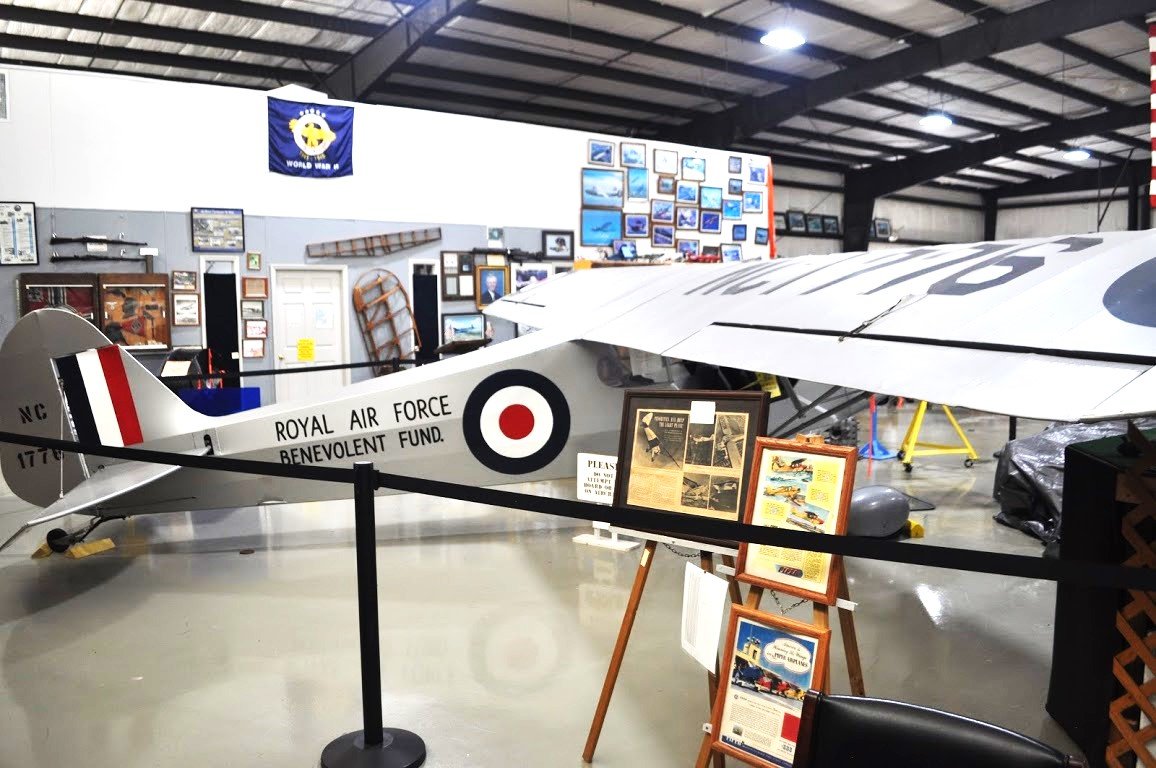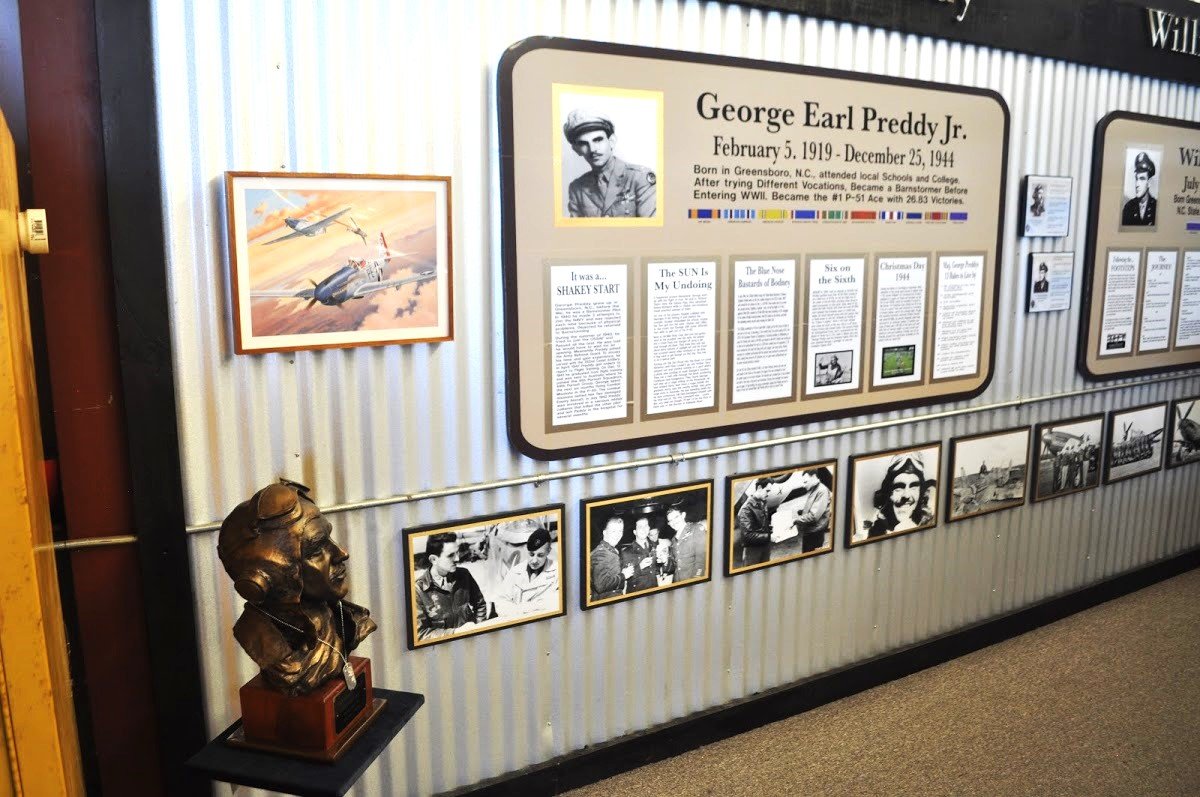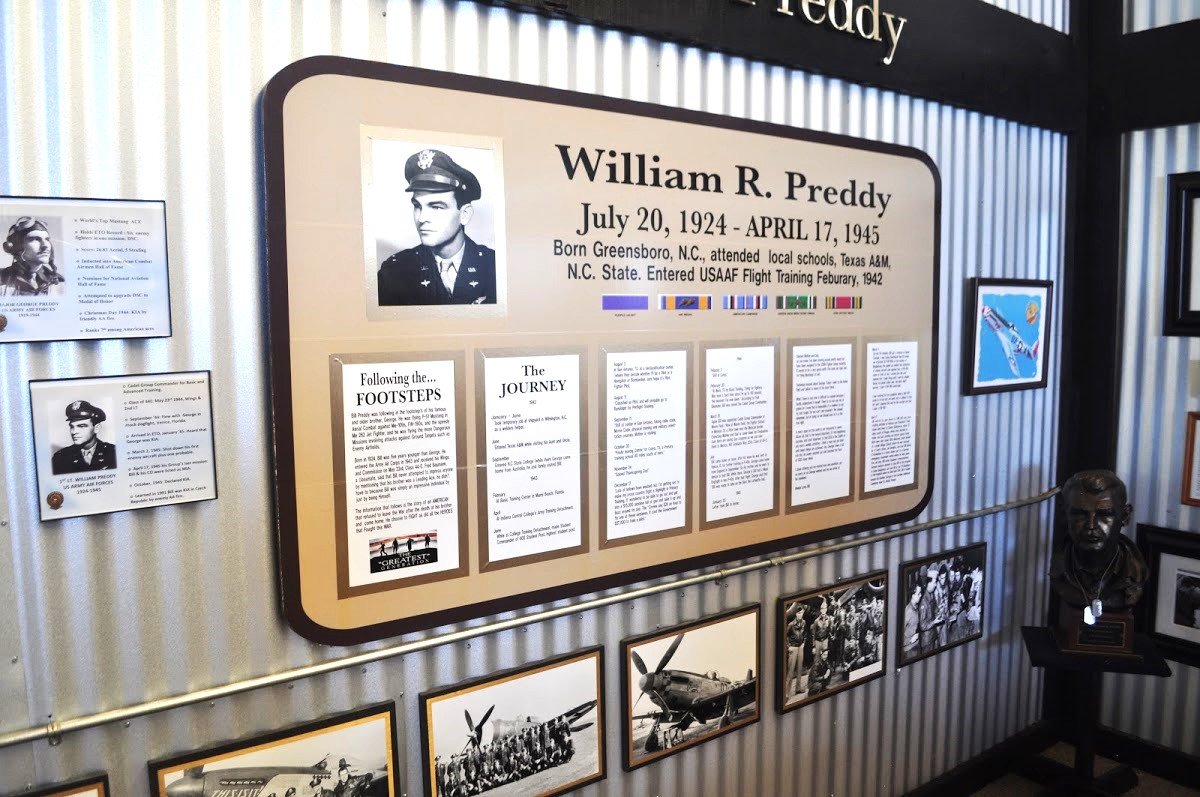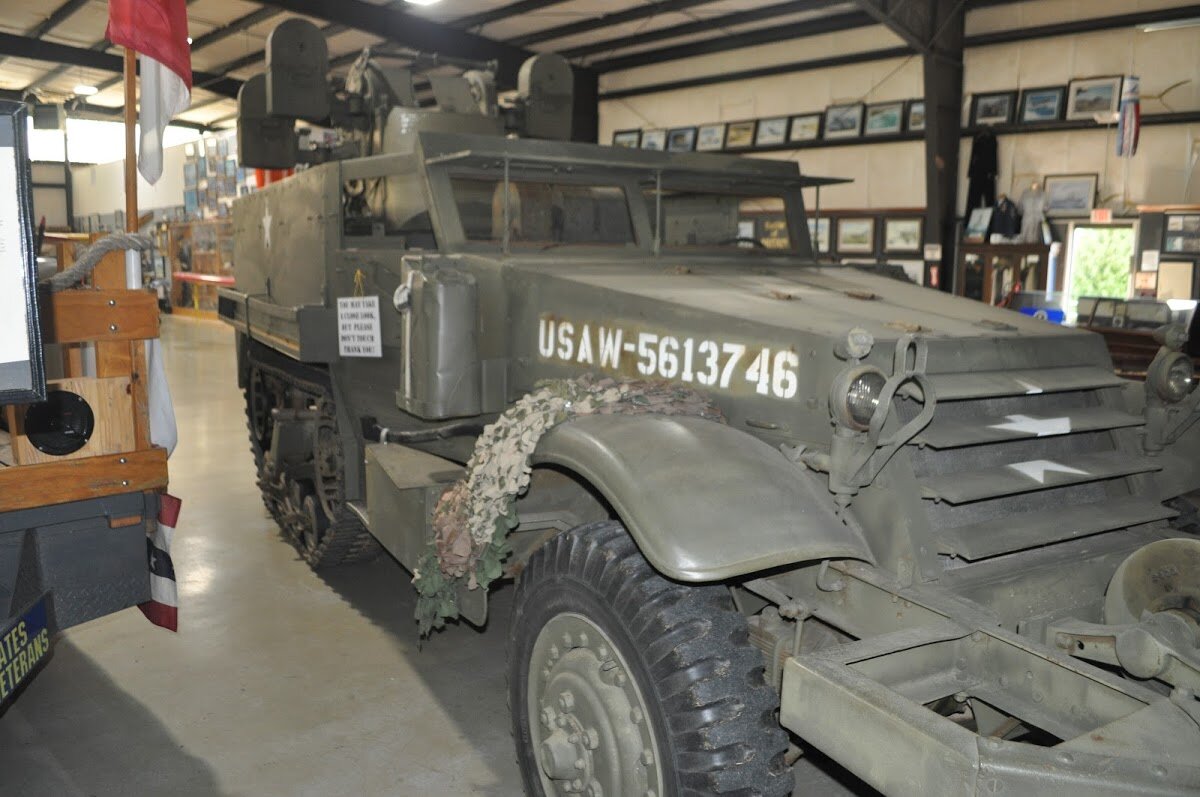North Carolina Aviation Museum Asheboro NC
Issue 16 North Carolina Aviation Museum
In the spring of 1941, Britain stood alone in the fight against the Third Reich. Although the US had not yet entered WW-II, there were many efforts going on to support Britain. The Lend-Lease program had just been enacted by Congress and equipment and supplies were beginning to flow to Britain. In England, The Royal Air Force Benevolent Fund was working to raise money for families of those killed and injured during the Battle of Britain and William T. Piper, the Chairman of Piper Aircraft, decided to donate a J-3 Cub to the effort. The Cub would be raffled off to raise as much as possible to donate to the fund. Piper dealers throughout the country joined the effort and raised enough money to purchase an additional 48 J-3s, one to be raffled in each state. The total of 49 planes were built in Lock Haven, Pennsylvania, between April 10th and 22nd, 1941. Each plane was given a special silver paint job and RAF insignia, and the planes were named for each state. Piper workers nicknamed the planes Flitfires (rhymes with Spitfires).
All 49 planes left Lock Haven on the 27th of April, 1941. The formation landed in Allentown, PA for fuel and then continued on to New York. Flying in close formation of seven rows of seven, they flew over all five boroughs of New York and made a low pass over the Statue of Liberty. The wing spent the night at Flushing Airport and flew, in formation, to LaGuardia Airport the next day. That night there was a huge Gala fund raiser, which included a drawing for the national winner. That Flitfire, registered as NC 1776, was won by Jack Krindler from New York City. The following day, the planes fanned out to the 48 states for their individual drawings and additional fund raising.
The 49th Flitfire also left on a national War Bonds tour. During the tour, the plane was flown by a variety of well-known pilots, including, it is said, Orville Wright. Not very many of the Flitfires are known to still exist, but NC 1776 does. Totally restored to its original colors, it is proudly displayed in the North Carolina Aviation Museum & Hall of Fame in Asheboro, NC.
Like many of the museums in this series, The North Carolina Aviation Museum & Hall of Fame was the dream of one man, Asheboro businessman Jim Peddycord. Peddycord had an interest in aircraft preservation and, in 1996, he held an airshow at Asheboro Airport. He planned to make the airshow an annual event to raise funds to build an aircraft collection and a museum. Tragically, practicing for the air show the following year, Jim and his son Rick died in a mid-air collision. Local businessman and vintage aircraft collector, Craig Branson, and other members of the association Jim had formed, worked together to continue Jim’s dream. They named the museum the Peddycord Foundation for Aircraft Conservation in his honor. By 1998, the museum had built a hangar and had found a B-25 for restoration. In 1999, a second hangar was built to house the B-25 and, in 2001, the museum was designated the North Carolina Aviation Hall of Fame. Today, the Museum houses a large collection of airplanes, artifacts, vehicles, and memorabilia.
You enter the museum’s Hangar 1 through a nicely organized gift shop. Once in the main museum area, you are on your own to explore the exhibits and it soon becomes clear that the focus of the museum is aircraft, people, and artifacts associated with North Carolina.
This Cox Hawk is a good example of the focus on North Carolina aviation. Bobby Cox, of Apex, NC, was a craftsman and entrepreneur. He started a furniture building business, built his own house, and also built his own airstrip. Over the years he constructed several airplanes and, in 1995, he built this one-of-a-kind aerobatic plane. Among other awards this attractive plane won in 1995 was Grand Champion at Sun ‘N Fun, and the prestigious EAA “Lindy” award.
There are numerous fascinating pieces of memorabilia throughout the hangar. In some areas they are organized and labeled in display cases. In other areas, you randomly come upon an unexpected piece of interest.
This WWII field desk, for instance, was just sitting under the wing of a plane. It is an intriguing item that could eventually make a very interesting exhibit.
I also found this display case engrossing. Each shelf contains an aircraft instrument, throttle quadrant or other artifact with a description, and some are combined with a model of the plane the item came from.
F-105G Model and Throttle Quadrant
In the center of hangar 1 is a second noteworthy J-3 Cub. Anyone who has seen air shows over the past 30 years has probably seen, or heard of, The Flying Farmer. Although there have been several air show performers doing a Flying Farmer act, Charlie Kulp may be the best known. His comedy routine is performed in a totally stock Cub, with the air show announcer playing the straight man. The routine consists of a ‘hayseed’ farmer, looking a little drunk, wandering out on the flight line. He ‘accidently’ gets in the Cub and starts it up. The crowd is then treated to a routine of wild, seemingly out of control, flying. The act usually ends up with the farmer dead sticking to a landing, swerving off the runway and ending up right in front of the crowd.
This notable plane sits just as it was after Charlie’s final performance in 2007, complete with signatures and best wishes all over the wings. Before retiring, Charlie gave over 800 performances in his Cub.
Piedmont Airlines was founded in Winston-Salem in 1948 and, throughout its history, it was very much a North Carolina airline. Since being acquired by US Air in 1988, and subsequently merged into American Airlines of today, the North Carolina presence has remained strong. One corner of Hangar 1 has a still-developing display of Piedmont history as well as a display case of American Airlines history.
Although the Museum has a North Carolina focus, there are many other displays of interest, including this attractive wall of Battle of Britain prints.
There is also this compelling display honoring the Tuskegee Airmen and there are several exhibits about notable contributions by women to aviation history.
Leaving Hangar 1, there is a short walkway to Hangar 2. There are picnic tables between the two buildings, a nice place for a family lunch.
Hangar 2 is a working hangar and many of the planes here fly regularly, including two 3/4 scale P-51 Mustangs. The B-25 that was originally housed here has moved on, but the centerpiece of Hangar 2 will soon be this A-26 “Spirit of N.C” which is newly based at the Museum.
Developed from the successful A-20 Havoc, The Douglas A-26 Invader was powered by two Pratt and Whitney R-2800 Double Wasps. Almost 2,500 were built and they served in all theaters during WW-II. After the war, the A-26 was re-designated the B-26, which is sometimes confusing because there was already a similar looking B-26, the Martin Marauder. The re-designated B-26 Invader continued in the Air Force inventory into the 1960s, operating in both Korea and Southeast Asia. The type was also operated by the Navy (JD-1D/DB-26J) and by the CIA for covert operations. Due to its longevity, many Invaders eventually found their way into civilian use and became some of the first corporate aircraft.
The Museum’s A-26 has a long and interesting history. Built in Tulsa and delivered to the Air Force in 1945, S/N 44-35911 went immediately into storage. In 1951, it was loaned to the French Air Force (l’Armee de l’Air) and was sent to Indochina, where the French fought from 1946 to 1954. Based in Da Nang, Saigon, and Hanoi, she participated in over 300 bombing missions. Returned to the Air Force in 1955, 911 was stored in the Philippines for several years. In 1959, she was converted to a civilian ‘Monarch 26’ and was the prototype for these civilian conversions by Rock Island Oil & Refining Company. As a corporate aircraft, 911 first flew with Rock Island Oil in Wichita and later with several other corporate operators. By the late 1970s, 35911 was flying as a warbird, eventually as part of the Coleman Warbird Museum. In 2001, she was purchased by George Lancaster, re-named The Spirit of N.C., and recently placed on loan to the North Carolina Aviation Museum. The Spirit of N.C. will hopefully be kept in flying condition and be seen in the air at future Museum events.
Besides aircraft, Hangar 2 contains a variety of other items, including restored and operational ground vehicles. Once things are back to normal, the Museum plans to return to having a number of air shows throughout the year. As in previous years, most of the shows will include various forms of re-enactments, putting the ground vehicles to good use.
This 1936 Ford Coach, in original condition, is an interesting period piece with a North Carolina connection. It appeared in the 1968 movie “Killers Three”, produced by Dick Clark and filmed locally.
One vehicle often seen in re-enactments is this 1942 Plymouth P-11. Produced in 1941 and 1942, the P-11 was widely used as a staff car in all branches of the military during WW-II.
Designed by Ford in the 1950s, the M-151 ¼ ton 4X4 utility truck (better known, of course, as a ‘jeep’) is very similar looking to the classic Willy’s Jeep models of WW-II. The M-151 was a greatly improved vehicle in many ways and was produced in greater numbers. Like other ‘jeeps’, several manufacturers built the M-151, this example being built by American Motors (AMC).
The WLA model Harley Davidson was produced during WW-II for general military courier duties. Besides the Army, it was also used by the Navy, Marines, and the militaries of other countries, most notably the Soviet Union. It is another fine addition to any WW-II re-enactment.
WW-II camp re-enactment from 2019. Photo courtesy of NCAM
This Aeronca L-16 is one of the planes in Hangar 2 that flies regularly. The L-16 is essentially a military version Of the Aeronca Champ which saw service in the 1950s, including during the Korean War. From 1955 on, many L-16s were transferred to the Civil Air Patrol, becoming a mainstay for that organization.
The Swiss-built Pilatus PC-3 first flew in 1953 and served as a trainer in the Swiss and other Air Forces for several decades. Pilatus eventually added a PT-6 turboprop as well as other upgrades, resulting in the PC-7.
Several other aircraft in Hangar 2 were previously operated as trainers in foreign Air Forces. This is a Scottish-built Bulldog. Designed by Beagle Aircraft, the B-125 first flew in 1969. Shortly after that, Beagle went out of business and production was taken over by Scottish Aviation (Bulldog) Limited. Over 300 Bulldogs were built, serving as a trainer in the RAF as well as in a number of other countries.
On the back wall of Hangar 2 is this very attractive and moving Memorial to brothers George and William Preddy, both born in Greensboro, NC.
George Preddy started out flying as a barnstormer before WW-II. After being turned down several times for Navy flight school, he persisted and finally graduated from USAAF flight training at the end of 1941. He was first assigned in the Pacific, flying the P-40. After a serious mid-air collision that left him in the hospital for two months, he returned to the US. Eager to get back to flying, he checked out in the P-38 and was then assigned to a P-47 squadron. Flying out of Bodney England, Preddy scored his first victory in December of 1943. By April of 1944, his squadron (487th FS, 352nd FG) had converted to P-51s and Preddy quickly became the leading active ace in the European Theater (ETO). After earning the Distinguished Service Cross, George was given leave in the US, but returned to flying as soon as he could, now as CO of the 328th Squadron. While supporting the Battle of the Bulge, he was shot down on Christmas Day, 1944. It is possible he bailed out at low altitude, but his body was found with the chute unopened. With 26.5 kills, George Preddy was the top P-51 ace, the 3rd highest ace in the ETO, and the 7th highest American ace in WW-II.
Five years younger than George, Bill Preddy followed in his brother’s footsteps. Graduating from flight school in the spring of 1944, he was sent to Florida to train in P-40s. When George came home from Europe that fall, he visited Bill in Florida. After a mock dog fight between the brothers, the elder George pronounced that “Bill was ready to take on the best the Luftwaffe had to offer”. At the time of George’s death, a few months later, Bill was on his way to Europe and did not hear about his brother’s death until mid-January. Assigned to the 339th Fighter Group flying the P-51, Bill Preddy claimed his first kill (an Me-109) during his 7th mission. On April 17th, 1945, Preddy and his CO gave chase to a pair of Me-262s near Prague. They could not catch the German jets and decided to make a strafing run before heading home. Both P-51s were shot down by ground fire. Bill managed to crash land his plane but did not survive.
The entire display is well documented and contains a number of interesting photographs. It is really worth spending time reading about these two local heroes.
Both hangars are full of interesting items, all displayed for close-up viewing. A good example is this Pratt and Whitney R-4360 28-cylinder engine. The Wasp Major engine was the largest production radial engine ever built. This particular engine came off a 1949 B-50D Superfortress, an updated and more powerful version of the B-29. The R-4360 was also used on the B-36, the C-124 Globemaster II, and the civilian Boeing 377 Stratocruiser. There are several other aircraft engines around the museum, each nicely restored and great to view up close.
The North Carolina Aviation Museum and Hall of Fame has the mission of preserving aviation and military history and they do it in a number of interesting ways. Exhibits are constantly changing and it’s a great museum to visit.
————————————————————————————————————————————————————————————————————
To learn about what to do in the local area, museum hours and costs as well as books to read and other interesting odds and ends, keep reading! At the end you will find a photo gallery of the entire museum.
PLANNING YOUR VISIT
Open Thursday - Sunday, 11:00 a.m. to 5:00 p.m.
Adults - $10 + tax (18+)
Military - $8 + tax (active or veteran)
Seniors - $8 + tax
Students - $5 + tax (7 - 17)
age 6 and under - Free
FLYING IN
Asheboro Regional Airport (KHBI) has a 5,500’ paved runway (3/21) with an RNAV approach to each runway. Fuel is available at Cardinal Air. There are tie-downs located right next to the museum.
LOCAL ATTRACTIONS
Asheboro is home to the North Carolina Zoo. At 2,600 acres, it is the world's largest natural habitat zoo and is located about 15 minutes east of the museum. https://www.nczoo.org/
Also near the museum is the American Classic Motorcycle Museum, specializing in Harley Davidson. The museum is co-located with the Heritage Diner, and it looks like a fun place to visit. They do not have a website, so call before you go to find out their hours. (336) 629-9564
WHERE TO EAT
There are a number of chain restaurants in the area, but for more local fare, try CJ's Olde Towne Restaurant (12 minutes away) or Golden Waffle diner (10 minutes away). Both are in the town of Asheboro. I did not have a chance to sample either of these, but they were recommended by museum staff.
SUGGESTED READING
The first decade of the 20th Century was an amazing time for aviation and Seth Shulman’s Unlocking the Sky relates that period from the point of view of Glenn Curtiss. Curtiss was involved with a number of personalities and projects of the time and this book takes a close look at these people and events. From his relationship with Alexander Graham Bell, to his attempt to fly Langley’s ‘aerodrome’, to his famous flight of ‘The June Bug’, we learn a lot about this amazing inventor. Most notably, his bitter legal battle with the Wright Brothers is a theme throughout the book. An excellent book suggested by reader Fred Scott. Thanks Fred! (The Glenn Curtiss Museum, in Hammondsport, NY, is on my short list to visit).
MUSEUM WEBSITE
UP NEXT
The Mid-Atlantic Air Museum, Reading Pa.
MUSEUMS ARE WHERE YOU FIND THEM
This segment is dedicated to finding interesting aviation artifacts that are in public view- but not in an aviation museum. If you see one send a photo!
Many museums not related to aviation have a plane or other aviation item in their collection. In this series, we have seen a Spitfire in the Glasgow Museum of Art in Scotland (issue 5) and a Pietenpol in The Museum of the Rockies in Bozeman Montana (issue 3). While visiting the Lane Motor Museum in Nashville, I was surprised to see that there are also a number of planes on display. If you are in Nashville, don’t miss this museum.
Most of the aircraft on display are Mignet light homebuilt biplanes, known as the ‘Flying Flea’. Frenchman Henri Mignet designed the plane in the 1920s and he first flew in public in his model HM 14 in 1933. Mignet printed and published his own plans for the construction of the Flying Flea and many of his planes were continued to be built up to the 1990s. Mignets have an unusual design, with staggered wings and no elevator or ailerons. Fore and aft on the stick controls the angle of attack of the front wing. Side to side with the stick moves the rudder. The plane is stable in flight, but not very graceful in a cross-wind landing!
This HM 293 model (being towed by a Vespa!) was the first of Mignet’s designs to have folding wings.
——————————————————————————————————————————————————————————————————————
A note about research. A wide variety of sources are used in writing this blog, and, as this is basically an opinion piece, not an academic work, sources are not usually cited. Obviously, though, my primary research is on the museum web-site. I never announce my visits beforehand, but I often get helpful answers to questions from museum staff while I am writing. Wikipedia, which, when used with caution, can be an excellent resource, and is frequently consulted. I occasionally get corrections and additional information from readers, and that is greatly appreciated. I also refer to books in my personal library, and I usually purchase a book or two at the museum shop, especially if (as in the case of Omaka in New Zealand), they publish a book about the museum. In this research, I sometimes come across conflicting information (such as how many aircraft were built). I always try to resolve the discrepancy with further sources, and information in this blog aims to be as accurate as possible. Tony Bruno, Kitty Hawk, NC.
——————————————————————————————————————————————————————————————————————
PHOTO GALLERY
Click on any image to enlarge
Hangar 1
Hangar 2
Issue 16, © Copyright 2020, all rights reserved. Except where noted, all photos by the author.








































































